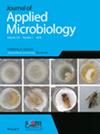Prevalence of streptomycin and tetracycline resistance and increased transmissible third-generation cephalosporin resistance in Salmonella enterica isolates derived from food handlers in Japan from 2006 to 2021.
IF 3.2
3区 生物学
Q2 BIOTECHNOLOGY & APPLIED MICROBIOLOGY
引用次数: 0
Abstract
The increasing prevalence of AmpC- and extended-spectrum β-lactamase (ESBL)- producing food pathogens is a serious public health concern. AmpC- and ESBL-producing Salmonella species pose a high risk of food contamination. AIMS This study aimed to investigate changes in the prevalence of Salmonella among food handlers in Japan from 2006 to 2021 using 100 randomly selected isolates from 2006, 2012, 2018, and 2021 with different serotypes and antimicrobial resistance patterns. METHODS AND RESULTS The average Salmonella isolation rate was 0.070% (19,602/27,848,713). Serotyping revealed that the most common serotypes were Enteritidis in 2006, Infantis in 2012, Agoueve/Cubana in 2018, and Schwarzengrund in 2021. Antimicrobial susceptibility testing showed that Salmonella isolates exhibited the highest resistance to streptomycin (< 40%), followed by tetracycline (< 20%-40%). Moreover, 6% of the Salmonella isolates produced cephalosporinases with the blaCMY-2, blaCTX-M-14, and blaTEM genes. The annual incidence of cephalosporin resistance has increased. Plasmid conjugation assays revealed that cephalosporin-resistant Salmonella spp. transmitted their resistance to Escherichia coli. Additionally, plasmid genome analysis showed that the insertion sequence IS26 was encoded in the upstream and downstream regions of blaCTX-M-14 and qnrS1 in the IncHI1 plasmid, which could be transmitted to other bacteria. CONCLUSIONS The tested Salmonella isolates showed high resistance to specific antibiotics, with differences in resistance depending on the serotype. Further increase and spread of transmissible cephalosporin-resistant strains should be noted.2006年至2021年日本食品处理者分离的肠炎沙门氏菌对链霉素和四环素的耐药性以及对第三代头孢菌素的耐药性的增加。
产AmpC和广谱β-内酰胺酶(ESBL)的食品病原体的流行率不断上升是一个严重的公共卫生问题。本研究的目的是利用 2006 年、2012 年、2018 年和 2021 年随机抽取的 100 例沙门氏菌分离物,调查 2006 年至 2021 年日本食品处理人员中沙门氏菌流行率的变化,这些分离物具有不同的血清型和抗菌药耐药性模式。方法与结果沙门氏菌平均分离率为 0.070%(19,602/27,848,713)。血清分型显示,最常见的血清型是 2006 年的 Enteritidis、2012 年的 Infantis、2018 年的 Agoueve/Cubana 和 2021 年的 Schwarzengrund。抗菌药敏感性测试显示,沙门氏菌分离物对链霉素的耐药性最高(< 40%),其次是四环素(< 20%-40%)。此外,6% 的沙门氏菌分离物产生了 blaCMY-2、blaCTX-M-14 和 blaTEM 基因的头孢菌素酶。头孢菌素耐药性的年发生率有所上升。质粒共轭试验显示,耐头孢菌素的沙门氏菌会将其耐药性传染给大肠埃希菌。此外,质粒基因组分析表明,IncHI1 质粒中 blaCTX-M-14 和 qnrS1 的上游和下游区域编码有插入序列 IS26,该序列可传播给其他细菌。应注意可传播的头孢菌素耐药菌株的进一步增加和传播。
本文章由计算机程序翻译,如有差异,请以英文原文为准。
求助全文
约1分钟内获得全文
求助全文
来源期刊

Journal of Applied Microbiology
生物-生物工程与应用微生物
CiteScore
7.30
自引率
2.50%
发文量
427
审稿时长
2.7 months
期刊介绍:
Journal of & Letters in Applied Microbiology are two of the flagship research journals of the Society for Applied Microbiology (SfAM). For more than 75 years they have been publishing top quality research and reviews in the broad field of applied microbiology. The journals are provided to all SfAM members as well as having a global online readership totalling more than 500,000 downloads per year in more than 200 countries. Submitting authors can expect fast decision and publication times, averaging 33 days to first decision and 34 days from acceptance to online publication. There are no page charges.
 求助内容:
求助内容: 应助结果提醒方式:
应助结果提醒方式:


